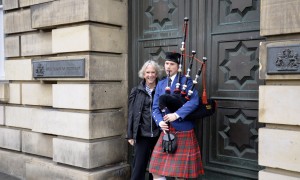by Sheryl Arredondo Jurries, Guest Blogger
On a recent trip to Scotland, my husband wanted to see St. Andrews, a lovely medieval town on the shores of the cold, windswept North Sea. I had been here before with my daughter Anna when she was 19 years old and thinking of doing a study-abroad program here. Prince William was a student here then so we visited his haunts, like a pub called Ma Bells. I remembered a few of the locations I wanted Jim to see from my previous trip here, so we hopped on a 40-passenger tour bus and scooted over to this wee gem of a lovely town.
Y’all know this town is the birthplace of golf, with it being played here as long as 600 years ago, but the first game was recorded in 1553 on the Old Course at St. Andrews. The Old Course hosts the British Open every 5 years. If you want to see it in person, unless you already have tickets and a hotel secured, you’ll miss it here on July 14. (The new course opened in 1895.)
There is a fantastic looking gray neoclassical building to the right of the 18th hole, which is the Royal and Ancient Golf Club, a.k.a. R&A. It was a private invitation-only club for men, until it was opened to women in 2014. Next to it is the Hamilton Grand, which, according to local folks, was built to upstage the R&A by an angry American who was denied membership. It became dorm rooms and is now filled with very swanky apartments for the rich. Supposedly, Samuel L. Jackson owns one.
Nearby is the West Sands Beach where the opening scene in the movie “Chariots of Fire” features its characters running here.
On we went to St. Andrews Cathedral, which still draws big crowds to its impressive architectural ruins and ornate headstones in the graveyard. St. Andrew was one of the 12 apostles of Jesus. When he knew he was to be crucified, he chose to be hung on an X-shaped cross, also known as St. Andrew’s Cross. It’s the inspiration for the Scottish flag, the saltire. Some of St. Andrew’s bones ended up here because of a shipwreck, so the cathedral was built in 1160 and the religious pilgrims began arriving.
















Comments
1 CommentMary lockrow
Sep 23, 2024Wow….history I did not know